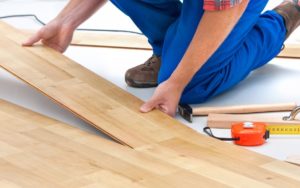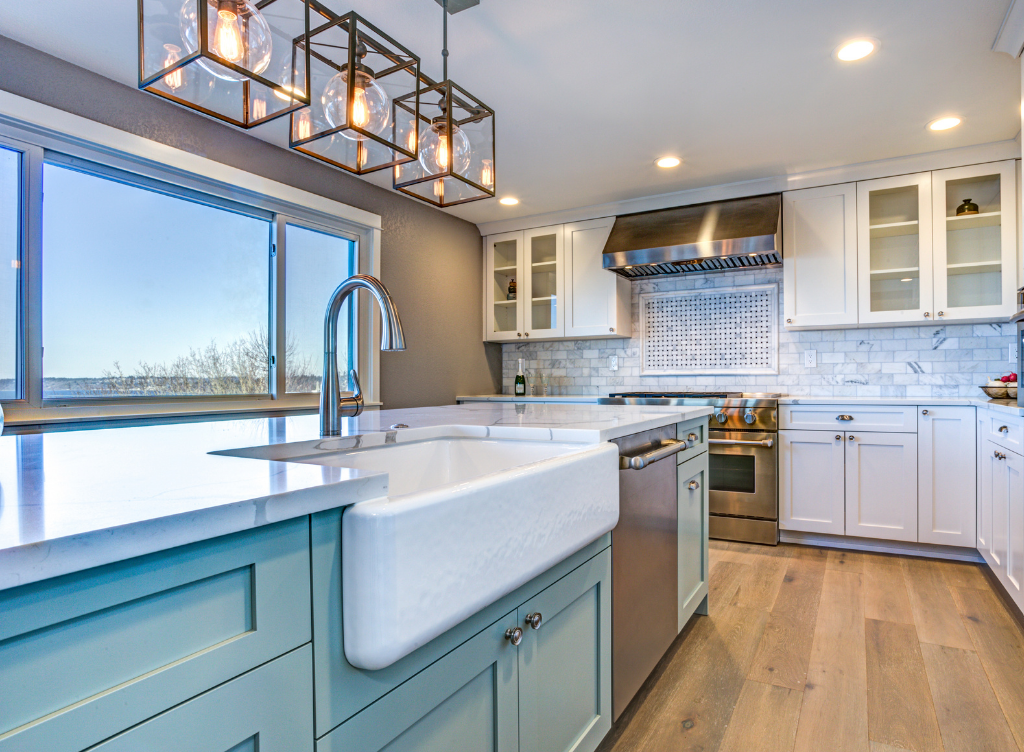

27 Feb Preventing Water Damaged Flooring
Sydney can experience long periods of heavy downpour. Unfortunately, many property owners suffer severe water damage every year because of this. If not floods, moisture can certainly make their way into homes and stores – destroying wood floors indiscriminately. This article will take a dive into ways to prevent water damage on your wood flooring, whether it be from small stains or a flooding.
Types of Wood Floors
There are many water resistant and waterproof floors in the market, like laminate floors, hybrid floors, and vinyl plank floors. However, many homes are equipped with real wood floors that are much more susceptible to water damage. Typically, the more real timber you have in a floor, the more likely it is for moisture to be absorbed. This can facilitate issues like mould growth, buckling, and other severe water damage.
Let’s quickly take a look at the responses of the three most vulnerable flooring types to water damage. If your floors are water damaged, the chances are that they are one of the following types:
Hardwood Floor
Hardwood floors are essentially planks that are real timber all throughout.
Because a hardwood floor is essentially 100% real timber, it is more susceptible to water damage. Water absorbed by the wooden material will cause the plank to swell.
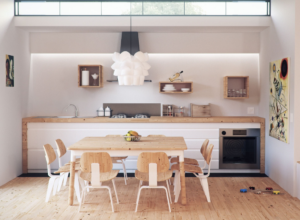

Engineered Floor
Engineered floors are basically planks with most of the design made mostly out of plywood, only a thin upped portion being real timber.
This construction has a lot less real timber than hardwood but has a high amount of plywood. Plywood is actually still susceptible to water damage as it is porous and absorbent. If water seeps through the real timber veneer, the wood floor can swell and buckle.
Bamboo Floor
Although bamboo flooring simply refers to the material of the plank, it is still classified as its own design. Like any other wood floor, it can come in both solid bamboo and engineered format designs.
Bamboo is a grass-fibre material that is naturally more water absorbent, making it less water-resistant than hardwood floors. High levels of moisture can be absorbed by the floors, making it unsuitable for areas of high humidity, especially kitchens and laundries.
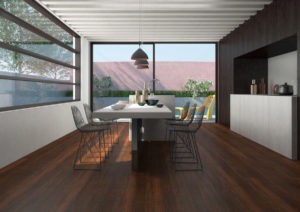
Water Damage on Hardwood Floors
There are different ways a floor can respond to water damage. Let’s take a look at floor water damage from small stains to harmful buckling.
Buckling
Buckling is the most serious water damage on hardwood. This occurs when the floor absorbs a high enough amount of water to make the boards warp. When a hardwood floor is wet, it is important to completely dry the surface as quickly as possible to prevent excess water from seeping between the boards. Otherwise, the boards can expand and contract so much that it has warped to the extent of being permanently damaged. You can tell this has occurred when your boards are popping out of the floor.
Mold Growth
Mold growth occurs when spores from the subfloor travel either through the air or through water onto a wood material. Water damaged wood floors are more susceptible to mold because the moisture provides an environment where these microbes may be able to thrive and grow. Also, hardwood floors have many microscopic spaces that can house microbes. This water damage can produce unpleasant odours and can even yield pathogens that make residents sick. The first step in dealing with mold and mildew is to keep areas dry and well ventilated. Making use of fans can speed up the drying process, but it is always important to dry surfaces as quickly as possible.
Stains
Stains are the smallest damage to your floor, usually caused by spills or leaks. This water damage only really occurs on the surface of floors and doesn’t do substantial damage, but it can definitely harm the aesthetic of an interior design. It is important to constantly clean the flooring to save the glamour of the surface coating. It could be very effective to thoroughly wipe the entire floor with a wet rag to remove stains and other dirt, but it is important to completely remove excess water in a quick-drying process to ensure no flooding occurs.
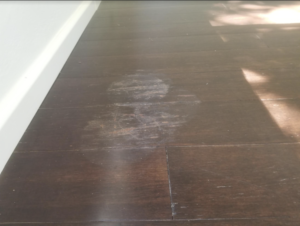

Ways to Protect Your Hardwood Floor
Now that we have examined the different types of water damage on various flooring, we can now take a look at some tips for minimising water damaged floors in your home.
Lay Waterproof Flooring
The best way to fix something is before the problem arises. By installing waterproof flooring like hybrid floors or vinyl planks, you can rest easy when it comes to moisture. Even a water-resistant laminate floor like AquaFloor or Kronoswiss can help you avoid many moisture related problems.
However, if you don’t have waterproof flooring, here are some great methods to protect your floors.
Blocking Rain Water from Entering Your Home
In the event of a flood, it is important to stop the entry of water into the house to prevent water damage on the floor. Some ways water damage can occur is through persistent leaks and water running in through underneath doors and cracks.
To combat roofing leaks, buckets could catch the dripping water to prevent any moisture from touching the floor. In the long term, it would be beneficial to seek professional help to repair water damage on the roof that allows water to come into the house.
Preventing water from running into the house can be done by laying sandbags on openings. A large and thick line of sandbags could slow a flood to the level of minimising a large portion of water damage. During Hurricane Sandy, this method was used to protect hundreds of homes from moderate flooding.
Luckily it rarely floods in most areas. The least we can do is close the windows during a downpour to protect the floors.
Covering Your Hardwood Floor
To avoid small water damages like stains, buying mats and rugs can be a good way of dealing with potential spills. This protection can serve as an intermediate layer that absorbs most excess water before it reaches the flooring. You may be able to get rugs that are 100% waterproof to draw spills away from sections of the floor.
Moderate Water When Mopping
It is important to avoid flooding the floor when mopping. This is because water can seep through the gaps between the boards and add unwanted moisture to the bottom side of the floorboards, harbouring potentially harmful bacterial growth. It would be beneficial to resort to other cleaning methods that are dry, like vacuuming or sweeping.
FloorVenue now stocks Bona branded cleaning mops which have a controlled spray attached which gives the perfect amount of moisture for a good floor clean.
Repair Your Hardwood Floor
Water damage can be at a level where the floor must be repaired or replaced. The right way to do so is by first seeking professional help to diagnose the signs of water damage then repairing damaged parts in a beneficial restoration of the facility. This can save sections of the floor, but sometimes the floor can be beyond repair. If parts need to be replaced, it would be a good idea to choose laminate or hybrid flooring, as they can deal with water more efficiently than natural wood floors.
